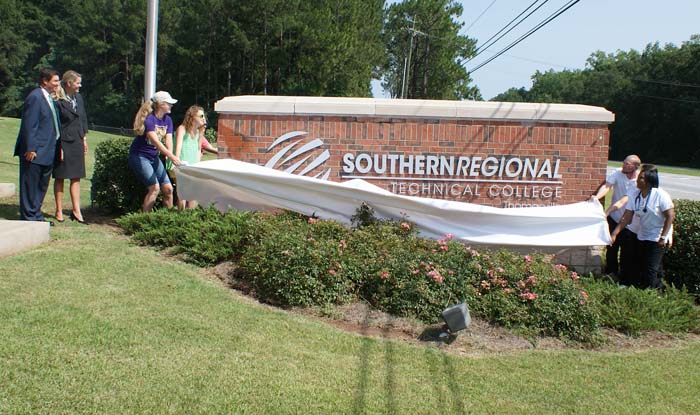New college produces more programming, enrollment boost
Published 5:14 pm Wednesday, July 1, 2015

- Southern Regional Technical College President Dr. Craig Wentworth, left, and Gretchen Corbin, commissioner of the Technical College System of Georgia, second from left, watch students unveil a new sign at the Thomasville campus on Wednesday.
THOMASVILLE — Southern Regional Technical College (SRTC) is more than just a new name. New educational opportunities are emerging from the merger of Southwest Georgia Technical College (SWGTC) in Thomasville and Moultrie Technical College (MTC) in Moultrie.
The move, marked by the unveiling of news signs on both campuses, became official on Wednesday.
“Today is a special day,” said Gretchen Corbin, commissioner of the Technical College System of Georgia Gretchen Corbin. “This is not the beginning. We have had many mergers in the technical college system and it’s been a long process, but this merger positions the college to put more people on the same page, to offer more programming and to increase enrollment.”
According to Dr. Craig Wentworth, president of SRTC, a veteran of the Technical College System of Georgia and former president of SWGTC, “The SRTC administration anticipates a total enrollment of over 3,600 students for the Fall semester with 157 programs of study.”
According to college officials, since the announcement of the merger of MTC and SWGTC in 2014, the administrations for both colleges have been steadily focused on the duties at hand: forming a new college that will provide greater access to services and programs for the students and communities they serve.
Wentworth said one of the biggest benefits of the merger is the ability to expand programs to areas where they couldn’t reach before. For example, he cited Tifton’s Megatronics program, saying that now it will be able to expand to Cairo High School.
The Technical College System of Georgia (TCSG) has used mergers as a way to reduce administrative costs while creating larger, more efficient colleges. In 2009, there were 33 colleges in the system. Since then, 17 have been merged into eight; the state technical college system is now comprised of 22 technical colleges and one technical division at a Board of Regents/University System of Georgia college.
As the previous mergers have shown, students experience little change in the day-to-day operation of their campuses. They have, however, gained from the benefit of a larger, more regional college that is more efficient financially and makes better use of shared instructional and technical resources among its campuses. There were no campus closings and the colleges’ programs, including credit, adult education, continuing education and customized workforce training for business and industry, will continue as before.
SRTC will serve a seven-county area with locations in Ashburn, Cairo, Camilla, Moultrie, Sylvester, Thomasville and Tifton. Moreover, Florida residents of Gadsden, Jefferson and Leon counties qualify for in-state tuition. The Moultrie-Veterans Parkway Campus, Thomasville Campus and Tifton Campus will be full-service locations, meaning students will have access to student affairs and enrollment services, academic offerings and adult education (GED). The Moultrie-Industrial Drive instructional site offers predominately Industrial Technology programs (e.g., Welding and Joining, HVAC, Automotive Technology, etc.) while the Grady County instructional site offers Practical Nursing and Early Childhood Care and Education credit programs, high school dual-enrollment and adult education. Additionally, adult education services are offered in Camilla, Sylvester and Ashburn.
The college will offer more 150 programs in the classroom/labs and for online students. Within the classroom setting there will be a significant expansion of night classes at all full-Service campus locations. Furthermore, administrators estimate SRTC will have one of the largest Move On When Ready (MOWR) (formerly known as dual enrollment) programs in the entire system, topping 1,100 students. MOWR allows high school students to earn both high school and college credit toward graduation simultaneously, with course tuition covered by state MOWR funds or the HOPE grant. SRTC currently collaborates with Baconton Community Charter School, Bishop Hall Charter School, Cairo High School, Colquitt County High School, Mitchell County High School, Pelham High School, Thomas County Central High School, Thomasville High School, Tift County High School, Tiftarea Academy, Turner County High School, and Worth County High School on MOWR programs.
In addition to Wentworth, the SRTC Presidents Leadership Cabinet will consist of a provost and nine vice presidents, responsible for ushering the new college into the future. Jim Glass will serve as provost for the new college; Paul Roberts will serve as vice president of administrative services; Ken Strickland will serve as vice president for strategic initiatives; Amy Maison will serve as vice president of institutional advancement, marketing, and public relations; Dr. Debbie Goodman will serve as vice president of institutional effectiveness; Dr. Annie McElroy will serve as vice president for academic affairs; Dennis Lee will serve as vice president of economic development; David Evans will serve as vice president of operations; Leigh Wallace will serve as vice president of student affairs; and Joyce Halstead will serve as vice president of high school initiatives and enrollment management.
In addition to the aforementioned leadership cabinet, over 275 full-time personnel, 83 part-time staff members, and more than 190 adjunct instructors will be a part of SRTC.





